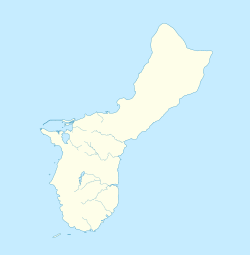| Faha Massacre Site | |
| U.S. National Register of Historic Places | |
 | |
| Nearest city | Merizo, Guam |
|---|---|
| Coordinates | 13°16′18″N 144°39′49″E / 13.27167°N 144.66361°E / 13.27167; 144.66361 |
| Area | 1.5 acres (0.61 ha) |
| Built | 1944 (1944) |
| NRHP reference No. | 91001091 |
| Added to NRHP | August 27, 1991 |
The Faha Massacre Site is located just behind the Pigua cemetery in the village of Merizo on the United States island of Guam. The site is demarcated by four concrete pillars, connected by metal cables, with several crosses placed inside that area. A metal plaque mounted on a concrete block commemorates the thirty native Chamorro men who were slaughtered here on July 16, 1944, by members of the Imperial Japanese Army (IJA) during the Japanese occupation of the island during World War II. The IJA routinely forced Guam's native population to work on its construction projects. The men who were killed here were rounded up for a work crew; why they were killed is unclear, as there were no survivors. The massacre took place one day after the Tinta Massacre (in which 46 were killed), and about one week before the liberation of the island began.
The site was listed on the National Register of Historic Places in 1991.
See also
References
- ^ "National Register Information System". National Register of Historic Places. National Park Service. July 9, 2010.
- "NRHP nomination for Faha Massacre Site". National Park Service. Retrieved 2015-05-13.
| National Register of Historic Places in Malesso, Guam | ||
|---|---|---|
| Historic properties |  | |
| See also: National Register of Historic Places listings in Malesso, Guam | ||
This article about a property in Guam on the National Register of Historic Places is a stub. You can help Misplaced Pages by expanding it. |
This article about a Guamanian building or structure is a stub. You can help Misplaced Pages by expanding it. |